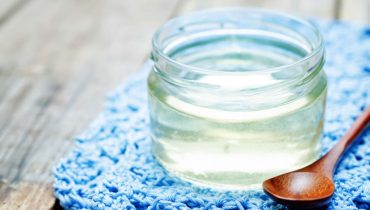How To Use Glycerin In Dry Non Humid Weather
 Glycerin is one of those ingredients everyone loves to hate including me. My reasons are varied; at first I didn’t like it because all the cool girls hated it.
Glycerin is one of those ingredients everyone loves to hate including me. My reasons are varied; at first I didn’t like it because all the cool girls hated it.
Then I didn’t like the sticky texture and thought it would make any concoction I made a disaster without even testing it out and finally I tried a product that was heavy on the glycerin and totally hated it which sealed the deal for me.
I would see glycerin all the time at my local vitamin shop and just breeze right on past it and also ignored all products that had it listed on the top half of an ingredient list without even batting an eyelid.
But then as karma would have it, my mom came into town and brought some for me, so now the thing was staring at me every time I open my hair stash drawer.
Obviously I wouldn’t dare throw it away because then I would have to lie if she ever asked me about it so on a cold winter morning I decided after years of ‘band waggonist’ hate, to give glycerin a real shot.
Few of us use glycerin during the cold periods of the year, for the simple fact that the air is dry and glycerin thrives on moisture.
Glycerin is a humectant which simply means that it attracts moisture. During humid weather, it draws moisture from the atmosphere and into your strands which keeps your hair soft.
On the other hand in drier weather when there is no moisture in the air then the story goes that glycerin will take moisture from the next best source, your strands!
Have you ever used a product in your hair and it feels great while your hair is wet and then once your hair dries it’s as if you did not put anything in it and it ends up looking and feeling like straw? Well that’s kind of what a lot of women report happens to their hair when they use just glycerin during dry periods.
The good news is you can work your way around this trait. So if you can’t bare to throw your S Curl Moisturizer to the back of the cabinet for the entire winter, here are three tried and true ways that you can actually use glycerin at the time of year.
 1. Mix with water based moisturizers or mix with plain water.
1. Mix with water based moisturizers or mix with plain water.
The thing is glycerin actually works pretty well as an all round moisturizer when you combine it with plain water or a water based moisturizer.
A water based moisturizer is anything that has water listed as the first ingredient and can be used to add moisture to your hair.
We all know that ideally the best moisturizer for our thirsty strands is water and since glycerin has an affinity to water, combining both will lead to less loss of moisture during those cold winter months.
An easy way to accomplish this is to use it as part of the LOC method of moisturizing your hair. Mix your glycerin with water to be used as the liquid part of the LOC method.
Just one more thing: Ensure that you have more water than glycerin in your mix; a great measurement is 1 part glycerin to 3 parts water.
2. Block with an oil
A glycerin containing moisturizer can be combined with a light oil to seal in the moisture into your hair during low humidity weather. Essentially you are locking everything up in the strand so nothing gets out.
You get to keep your moisture and reap the benefits of your oil, which is a win win situation.
3. Block the glycerin with cones
Don’t be mad! I know a lot of naturalistas or healthy hair journey advocates constantly talk about the evils of silicones. But cones can and have been used as part of healthy hair journeys with no problems. It all just depends on how you add it into your regimen and how your hair responds to them.
Some of us try to avoid cones at all costs due to the buildup it can lead to if used excessively so I understand that this option might be the least favorite of the bunch for some but nonetheless it is an option if you want to use glycerin during dry weather.
Really the concept with silicones and glycerin is the same idea as described with the oil above. Cones tend to counter the negative effects of glycerin by blocking in moisture into your hair keeping your hair as moisturized as you planned.
To be clear our hair doesn’t always react as expected in different weather conditions and to definitively predict what your hair will do in various seasons can be difficult, a lot of it depends on the individual’s hair porosity, the thickness of your strands and a number of other factors that can cause your hair to react in a variety of ways.
In other words if you want to try glycerin, just do it you never know it might just surprise you!


